I may earn a small commission from purchases made through product links on this website at no extra cost to you. As an Amazon Associate I earn from qualifying purchases.
Last updated: August 16, 2023
This guide explores the nutritional benefits of roasted seaweed, also known as nori, a Japanese staple with a unique taste.
I have always been quite a bit of a sushi addict. The freshness of this type of Japanese food, the many flavors, the variety in colors; I could literally eat it every day.
Sushi ingredients like salmon, egg, tuna, and chicken are typically quite tasty and nutritious, but what about that crunchy layer of green goodness that holds everything together?
This layer is roasted seaweed, also known as sushi nori or nori seaweed. Keep reading, and learn more about this surprisingly tasty Japanese delicacy.
Quick navigation:
What Is Roasted Seaweed?
When you think of sushi, what’s the first thing that comes to mind?
Fresh fish, creamy avocado, and… that dark, thin wrap holding it all together? That’s Nori, the unsung hero of the sushi world. Hailing from the ocean, Nori is the edible seaweed that transforms a heap of rice and fish into a bite-sized delight.
But Nori isn’t just limited to sushi. Head to Japan, and you’ll find it toasted, seasoned, and enjoyed as a crunchy snack. It’s like the sea’s version of a potato chip, but with a nutritious twist. Packed with vitamins, minerals, and even protein, Nori offers more than just a crispy bite.
Its deep green, almost black hue, isn’t just for show. When dried and roasted, Nori develops a slightly salty, umami-rich flavor, making it a versatile ingredient for many dishes.
Manufacturing Process
In Japan, nori seaweed used to be the generic term for all seaweeds. It now represents the edible seaweed species of Porphyra (red algae, cold water seaweed), according to Wikipedia.
The roasted seaweed product is made by shredding, drying, and roasting the nori seaweed, similar to the process of making paper. The end product is a thin (like paper) black or green sheet of around 18 by 20 cm.
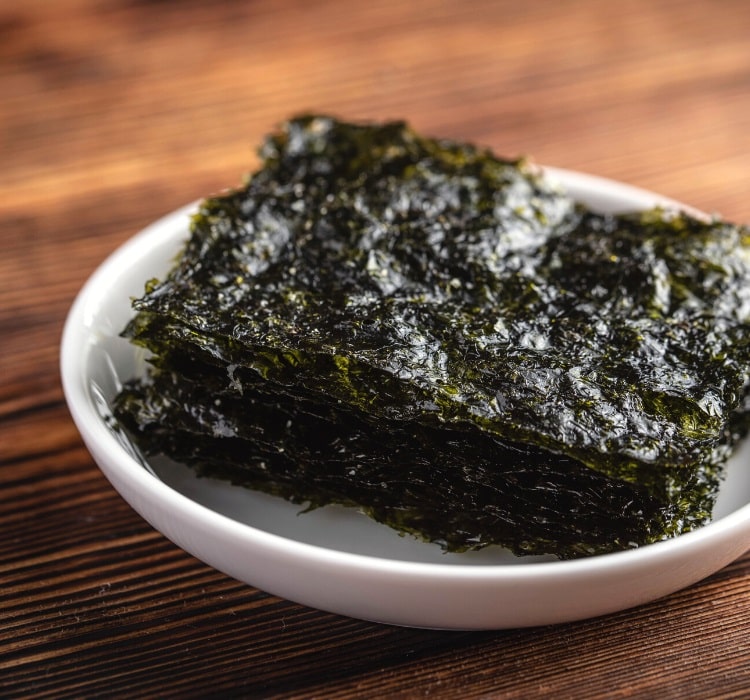
What’s good about this manufacturing process is that not much else is added apart from a bit of oil and (sea) salt.
So, roasted seaweed is almost pure, with only a few extra ingredients added to make it crunchy. And that makes it an excellent alternative to potato chips as a snack, for example.
Nutritional Benefits
Surprisingly, Nori seaweed is actually classified as a vegetable, or rather, a sea vegetable. And over the years, it has certainly evolved into one of my favorite sea vegetables.
Many of us may never have tasted seaweed before, but the Japanese have been eating this type of food for centuries. They appreciate nori as being a food of longevity.
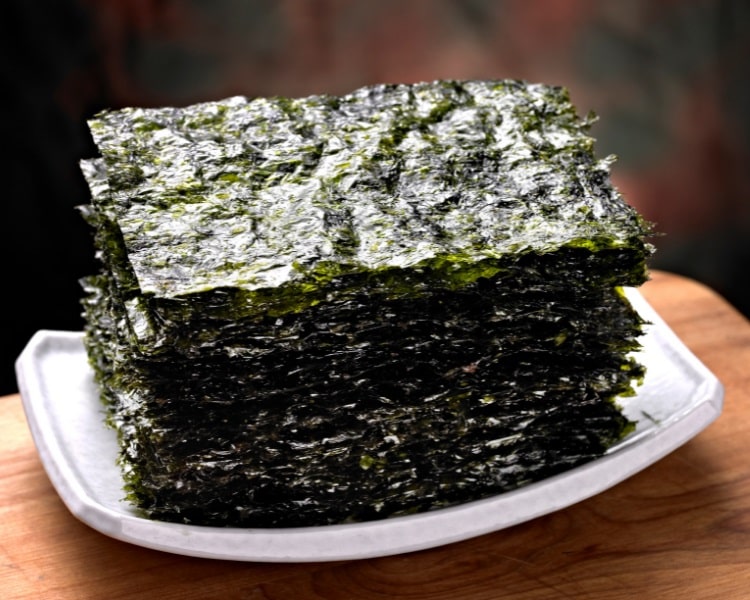
With quite an impressive nutritional profile, here are some of the benefits of eating roasted seaweed regularly.
1. High in Iodine
Roasted seaweed (or any type of seaweed, for that matter) is a rich source of iodine. Iodine is a mineral that is essential for your metabolism and helps your thyroid gland to function the way it should be.
One sheet of nori contains around half of the daily recommended intake of iodine.
2. Source of Vitamin B12
Vitamin B12 supports the normal functioning of the brain and nervous system, and helps form red blood cells. Edible algae in general, including nori and also spirulina, is a great source of vitamin B12.
3. High in Potassium
Potassium is a mineral that helps lower your blood pressure and lowers your risk of stroke and heart disease. Nori contains 50 mg of potassium per 1 sheet.
4. Contains Protein and Fiber
While the amounts are, of course, not super high, roasted seaweed does contain some protein and fiber.
5. Low in Calories and Saturated Fat
Roasted seaweed is incredibly low in calories, with one sheet, on average, containing only five calories. The amount of fat in nori is almost negligible.
6. Delicious Taste
This is, of course, not a health benefit, but the delicious taste of roasted seaweed makes it so much easier to eat it as a healthy afternoon work snack. The taste and texture are quite unique, making this snack hard to compare with anything else.
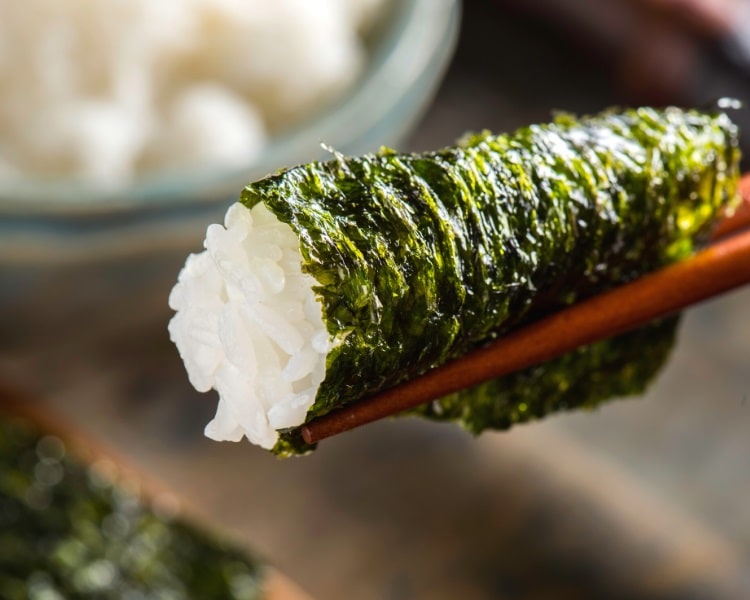
In addition to the above benefits, it’s also worth mentioning that roasted seaweed chips are a good source of calcium, phosphorus, magnesium, and vitamin C.
Where Can You Buy Nori?
Nowadays, you should be able to find roasted seaweed in any major grocery store or otherwise at your local Asian supermarket. You can also find it online, on eBay or Amazon, for example.
But perhaps your best option is to go to a Japanese restaurant and indulge in some delicious, freshly prepared sushi.
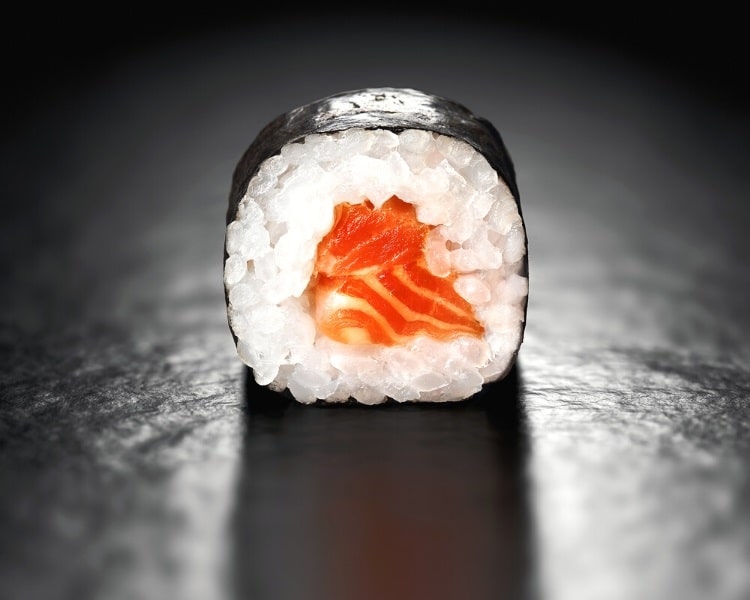
If you get roasted seaweed chips from the supermarket as a snack, make sure you read the label carefully. The list of ingredients should be short and simple.
It should really only contain seaweed, vegetable oil (or any other type of oil), and (sea) salt. Watch out for extra ingredients such as added sugar or other artificial surprises. I would also recommend buying organic if possible.
Another thing to watch out for when buying sushi nori is the transparency and color. There are various types of roasted seaweed, and the darker the color and the less transparent they are, the better the quality.
As with so many things in life, sometimes it pays to spend a little bit more.
- USDA Organic Roasted Seaweed
- Low calorie Superfood
- Packed with vitamins, minerals and amino acids
How to Eat Roasted Seaweed?
There are different ways to eat roasted seaweed, but sushi is probably the most popular. You can get sushi anywhere these days, but if you get it as a takeaway, make sure it’s still fresh.
Simply check the color of the ingredients and check if the seaweed still looks crunchy enough.
Another way to eat roasted seaweed is to crumble it into very small pieces and add it to your favorite recipes. You can also sprinkle it over salads for an extra bit of flavor and decoration.
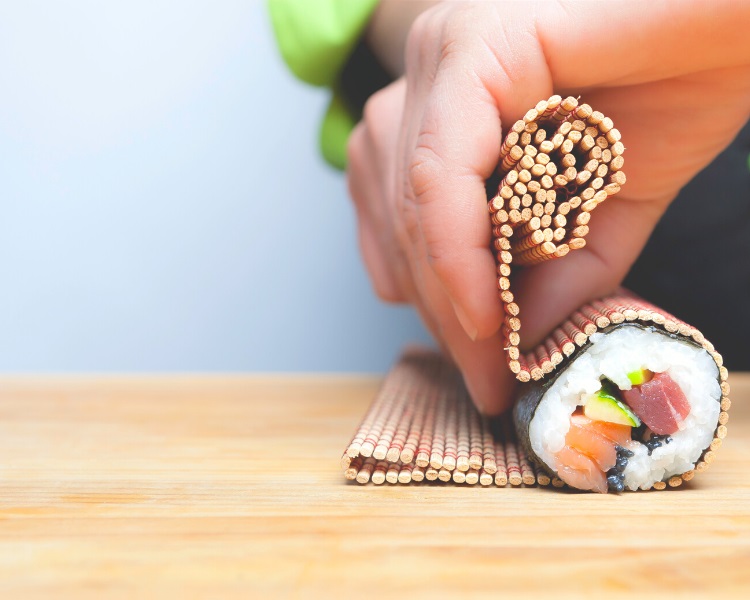
Roasted seaweed also works great as a snack by itself. It’s light, it’s easy to carry around with you, and it’s super delicious.
So, for your next afternoon snack, why not leave your chocolate bar or bag of potato chips at home and try roasted seaweed sheets instead. I find roasted seaweed as a snack to be quite satisfying.
Other Types of Edible Seaweed Snacks
Roasted seaweed is just one of many different types of edible seaweeds available out there. If you’re keen to eat more of this kind of food, read my guide on how to eat more seaweed for a list of practical tips.
Here are some more popular seaweed snacks:
-
Kelp:
Very rich in iodine and calcium, kelp is probably the most popular and most available type of seaweed. -
Arame:
Arame, also known as sea oak, is a type of kelp. Arama has a brown color and has a mild, sweet flavor, which makes it popular as a side dish. -
Kombu:
Kombu is also a type of kelp that can be eaten fresh as sashimi or in a dried form. -
Wakame:
Wakama, a dark leafy green, is another popular edible seaweed that you will often find in Japanese recipes. It has a similar nutritional profile as kelp, rich in iodine, calcium, and magnesium. -
Dulse:
Dulse is a red-colored edible seaweed (red algae) and is a popular snack food. Perhaps it is not as rich in iodine as kelp, but it has high amounts of dietary fiber, magnesium, and calcium.
Final Thoughts
Nori, or any type of seaweed, is a very nutritious sea vegetable that can be a great addition to your daily food routine.
The roasted seaweed version is widely available and is an excellent alternative to other, not-so-healthy, snacks you may be eating during the day.
The nutritional benefits of roasted seaweed are quite surprising. So if you’ve never eaten it before, I hope this article has inspired you to try nori or one of the other seaweed snacks.
Who knows, you may find that it is the perfect afternoon snack for you!



Love it, eat one packet every day, very good taste, no need other dirty fatty snacks.
Couldn’t agree more! Thank you, Singh.
I love it.
Thanks Maureen, glad to hear you like roasted seaweed as much as I do.
I love seaweed… I can eat the whole package, sometimes I do.
Haha, me too. Glad you like roasted seaweed as much as I do, Nina!
Same here!